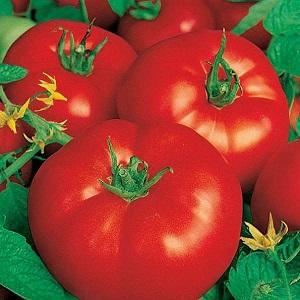The ideal variety for obtaining a rich, tasty, early harvest of tomatoes: the “Skorospelka” tomato
Among early tomatoes, the “Skorospelka” variety is especially popular. These are low-growing, unpretentious plants, the fruits of which are suitable for early salads and processing.
Let’s analyze the characteristics of the variety and decide whether it’s worth growing it on your own plot.
Description of the variety
Tomato variety “Skorospelka” is ultra-early ripening. The first fruit ripens already 87-95 days after sowing the seeds. The variety bears fruit well both when grown in open ground and in greenhouses. The height of the bush reaches 50-70 centimeters. Plants require moderate pinching and fastening to a support.
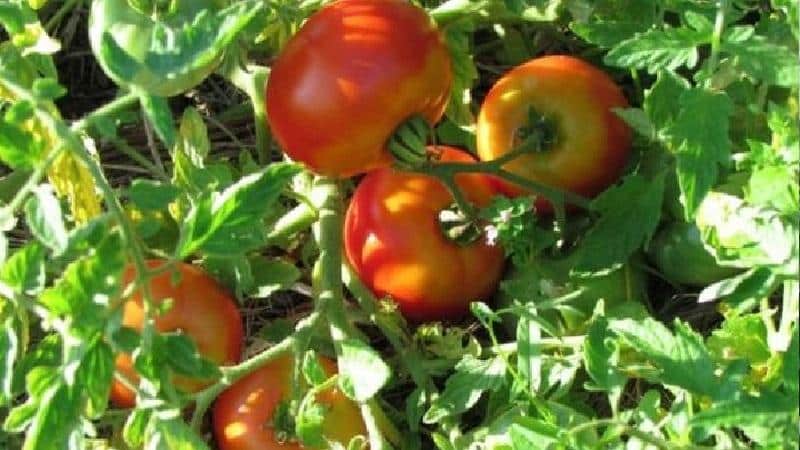
Subspecies of the variety
In addition to simple early ripening, The following hybrids are distinguished:
- "Syzran early ripening" – the tomato was bred by breeders from the city of Syzran, Vladimir region. The main distinctive characteristics of the variety include: tall indeterminate bush, up to 180 cm high; plum-shaped fruit with a sharp nose and crimson skin color at ripeness.
- Tomato "People's quick ripening" – developed and improved for the northern regions of Russia. It is distinguished by smaller fruits (up to 100 g), increased yield, dense pulp and sweet taste.
Distinctive features
The peculiarities of the “Skorospelka” variety include the unusually earlier ripening of fruits even compared to other early ripening varieties.For an early variety, the tomato has impressively sized fruits and is resistant to temperature changes in the spring, when the plant is just beginning to take root after being planted in a permanent place of growth.
Fruit characteristics and yield
The fruits have a round, slightly flattened shape. The skin of ripe fruits is red, however, with uneven lighting an orange tint is observed.
The pulp has a high content of useful substances, has a sour-sweet taste and a pronounced aroma. The average fruit weight ranges from 130 to 150 g. The average yield of one branch is 6-7 fruits or 5-7 kg per 1 sq. m landings. The flowers are simple, white with a yellow base.
Good to know:
How to grow seedlings
Let's consider step by step how to grow viable and productive seedlings for this variety.
Seed preparation
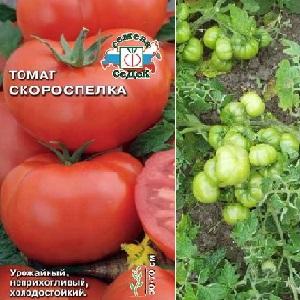 You can sow the seeds dry, but it is better to soak them first., because This will not only increase and speed up germination, but will also allow the selection of low-quality seed material.
You can sow the seeds dry, but it is better to soak them first., because This will not only increase and speed up germination, but will also allow the selection of low-quality seed material.
Selecting a solution for soaking seeds:
- a weak solution of potassium permanganate (pick the powder onto the tip of a match and dissolve in 1 liter of water);
- ash solution (dissolve 2 tablespoons of powder in 1 liter of boiling water);
- solution of the drug "Fitosporin-M" (the dosage is indicated on the packaging of the drug).
This procedure will disinfect and disinfect the soil., will accelerate seed germination and increase the plant’s protective functions against various diseases. Seeds that float to the surface during soaking are discarded and not used for planting.
Container and soil
A wide range of ready-made soils are available for sale for growing seedlings.. To make your own soil, mix garden soil, peat and sand in equal parts. Pour the resulting soil into a box.
In terms of alkaline composition, slightly acidic soil with a pH of 5-6 is preferable. It is very convenient to use containers specially made for this purpose or the most ordinary food containers from a hardware store as a planting box.
Sowing
It is optimal to plant early-ripening tomato seeds 50-60 days before the expected date of planting the plant at a permanent growing location. In the prepared planting box, distribute the seeds over the surface of the ground and sprinkle with a little earth.
The height of the soil layer should not exceed 1.5 cm. Water with warm water and after 6-7 days the first shoots will become visible. Temperatures below +24 degrees at this time can harm fragile plants.
Growing and care
As soon as two leaves appear on the seedlings, we begin picking them. This occurs approximately on the 15-21st day. When transplanting a seedling, you should deepen it to the cotyledons (lowest) leaves and protect it from direct sunlight for several days for adaptation. For good growth and health of seedlings, a special temperature regime is important. During the day, keep the temperature from +20 to +25 degrees, and at night not lower than +18 degrees.
When watering, seedlings like moderation: Excessive humidity will lead to the development of diseases (for example, black leg) and plant death. Water the young shoots only when the soil dries out a little. The seedlings are fed once every two to three weeks. Fertilizers based on potassium and phosphorus are mainly used for feeding.
Other varieties of tomatoes:
How to grow tomatoes
Landing
12 days before planting in a permanent place, seedlings begin to harden. Plants are placed in open sun for several hours a day and at a temperature of +10 to +15 degrees.
To prevent diseases, Before planting in open ground, the soil is treated with a manganese solution.
No more than 6 plants are planted per square meter. A mixture of soil and humus is added to the bottom of the planting hole.
Advice! After planting, it is advisable not to water the plants for 7-10 days. This way their root system will form stronger and the roots will go deeper.
Plant care
Let's consider main principles of care for plants.
Lighting
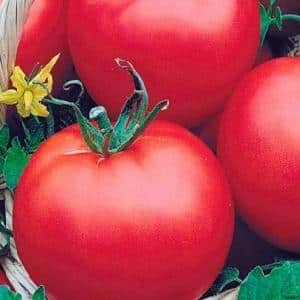 Tomato is a heat-loving and light-loving plant. The brighter and more intense the light, the better. The most favorable temperature is considered to be from +20 to +25 degrees. From lack of light, the plant stretches and weakens.
Tomato is a heat-loving and light-loving plant. The brighter and more intense the light, the better. The most favorable temperature is considered to be from +20 to +25 degrees. From lack of light, the plant stretches and weakens.
Watering
Tomatoes do not like too frequent watering. It is optimal to water abundantly once a week.
Effective and convenient methods include drip irrigation, when a thin tube is connected to each plant, from which the plant constantly receives a small amount of water.
Tomatoes respond to such watering with increased fruiting and larger fruits.
Weeding and loosening
Regular weeding and loosening the soil will improve the circulation of oxygen at the roots of the plant, due to which it will more effectively absorb the necessary nutrients and elements.
The hard crust of the earth will not only create unfavorable conditions for the roots, but can also damage the delicate skin of the stem, which will weaken it against fungal and bacterial infections.
Pinching and shaping the bush
7-10 days after planting the plants, pinching is carried out. It is optimal to grow an early ripening bush with three stems. To do this, two lower stepsons are left on the main stem. All other stepsons on the plant are removed.
Try to remove the stepsons before they reach a length of 3-4 centimeters. When breaking off a stepson, it is preferable to leave a small stump, so the growth of stepsons in this sinus will be stopped.
Garter
The early ripening bush has a fairly spreading bush that requires staking. Seedlings are tied up immediately or after 6-7 leaves appear on it. The bushes are tied up: to a stand, which is installed 10 cm from the plant; to a trellis with tensioned wire or to greenhouse guides.
Top dressing
At different stages of growth, plants use fertilizers of different compositions.. Thus, at the growth stage of a young plant, it requires nitrogen-containing fertilizers, and during flowering and fruiting, potassium-phosphorus fertilizers.
Important. It is important to use nitrogen fertilizers only according to the instructions, strictly following the prescribed dosage! A lack of nitrogen will slow down the growth of the bush, and an excess will slow down the formation of fruits.
Features of cultivation and possible difficulties
Skorospelka is an undemanding plant. It is enough to provide it with regular watering, loosen and weed the soil, periodically pamper it with mineral and organic fertilizers, and the plant will thank you with a generous harvest.
Hill up tomatoes twice a season, this will allow the plant to grow additional roots from the stem.
Diseases and pests
Tomato variety "Skorospelka" unpretentious and has good immunity, however, for prevention and additional protection it is advisable to use microbiological preparations (for example, Fitosporin).
If pests were found on the plant (spider mites, aphids, caterpillars and others), then the leaves and stems of the plant are treated with pesticides of natural or synthetic origin (for example, copper sulfate).
Advice! To prevent late blight from settling in the greenhouse, open and place 2-4 bottles of regular iodine from the pharmacy in it at an equal distance! Its vapors will effectively fight spores of fungal infections and pathogens of bacterial diseases!
The nuances of growing in open ground and in a greenhouse
There is no fundamental difference in the type of cultivation. In open ground, watering varies depending on the amount of precipitation. During the dry season, it is enough to water generously once a week; during rainy periods, additional watering is not required.
Harvesting and application
Harvesting early ripening occurs approximately 90 days from the moment of sowing the seeds. The fruits ripen together, which is convenient for their further processing.
The variety has a universal purposeTherefore, it is consumed both fresh and processed. The dense skin of the tomato prevents it from cracking during transportation and heat treatment.
Advantages and disadvantages of the variety
Advantages of the variety:
- unpretentiousness and good immunity of the plant;
- the bush blooms and bears fruit early, late blight appears much later;
- simultaneous ripening of a large number of fruits, which is convenient for harvesting;
- good transportability of fruits, resistance to mechanical stress;
- high yield at low temperatures;
- increased content of nutrients in fruit pulp;
- Suitable for growing both in open ground and in greenhouses.
Disadvantages of the variety:
- the need to remove stepsons and tie plants to a support;
- relatively low yield (compared to later varieties);
- lower sugar content (compared to later varieties).
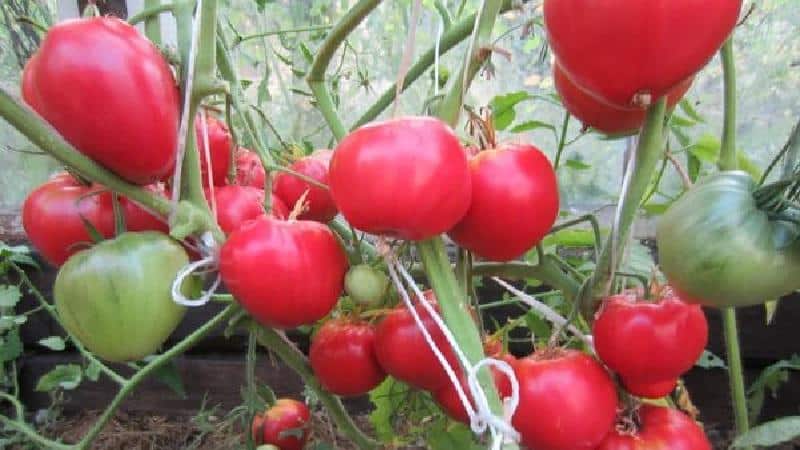
Farmer reviews
The experience of farmers cultivating early ripening on an industrial scale has shown tomato yields of 5-7 kg of tomatoes per 1 sq.m of planting. The fruits of the “Skorospelka” variety are most often used for the production of tomato juices.
In reviews of the tomato “Skorospelka” gardeners note the high quality of the resulting preservation and early timing of the first harvest.
Elena: “I bought the seeds according to the description; I had no growing experience. The result is excellent - the taste of canned tomatoes is beyond praise. At the same time, the fruits almost did not burst. I’ll plant again next year.”.
Vladimir: “If you need an early variety, you won’t find better than Skorospelka. This is the third year I’ve been planting seedlings of these tomatoes and I always get a harvest before my neighbors in the country.”
Conclusion
Among the early ripening tomato varieties, “Skorospelka” will be an excellent choice for a gardener. This is an unpretentious and stable variety with large fruits compared to other early crops. Ripe tomatoes are well stored and transported. Resistance to temperature changes makes the variety attractive for cultivation in the northwestern regions of Russia.
You probably shouldn’t plant “Skorospelka” over the entire area of the greenhouse, but it makes sense to grow several bushes in order to enjoy aromatic and fleshy home-grown tomatoes from your garden plot as quickly as possible!
